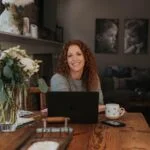
There’s something wonderfully relaxing about waking up under a pile of heavy winter blankets. But it’s not just the cozy warmth — the weight of those blankets is actually affecting your nervous system. It’s known as deep pressure therapy, or deep pressure stimulation, and a growing body of research is finding this therapeutic tool can work wonders for a calmer, happier state of mind — not to mention, better sleep.
What Is Deep Touch Pressure Stimulation, or Deep Pressure Therapy?
Deep pressure therapy, or DPT, is a form of therapy that uses firm touch to calm the nervous system, which is meant to help people feel less anxious or more relaxed. It may also be referred to as deep touch pressure stimulation or deep pressure stimulation.
“Deep pressure stimulation uses firm pressure to bring a sense of calm to an individual,” Kelly Murray, certified sleep coach, tells Sleepopolis. “This deep pressure can also boost serotonin levels, the happy hormone; reduce the stress hormone, cortisol; and increase melatonin levels.” That means this firm pressure, which can be applied through various methods including holding, hugging, squeezing, or swaddling, makes people feel calmer, more relaxed, and more open to rest.
Baloo founder Elizabeth Grojean points out that many people practice deep pressure therapy at home without even knowing it. “It might look like a massage, sleeping with a heavy cat on your chest, or asking your partner to lie on top of you,” she says.
Because it’s easy to do, this type of therapy has multiple applications. People who struggle with anxiety, those who’ve had a stressful day, and those with specific conditions such as autism, attention deficit disorder, post-traumatic stress disorder, sleep disorders, restless legs syndrome, and chronic pain, can all benefit. “Regardless of whether we have a diagnosable condition, we all have sensory needs — some of us need high sensory inputs and some of us prefer low,” Shannon Mead, a certified family therapist, tells Sleepopolis.
The accessibility of deep pressure therapy means everyone can benefit. The therapy can be as simple as a firm hug, curling up with a weighted blanket, or donning a special kind of vest. And the benefits can be impressive:
- Reduced stress and anxiety
- Better sleep
- A sense of calm and happiness
- Improved school performance
- Improved focus
How Does Deep Pressure Stimulation Work?
There are two parts to the autonomic nervous system — the sympathetic and the parasympathetic. The first is responsible for our ingrained “fight or flight” response and is sensitive to delicate touch, which is why a gentle tickle to the neck can feel so irritating. Meanwhile, the parasympathetic system manages functions relating to resting and digesting, and its activation has a body-wide calming effect. “Deep pressure stimulation affects your parasympathetic nervous system,” Stephen Light, certified sleep science coach and CEO/co-owner of Nolah Technologies, tells Sleepopolis. “The gentle pressure activates touch receptors, producing a calming effect by boosting serotonin, dopamine, and oxytocin.”
The sympathetic nervous system triggers the body’s reaction in stressful scenarios. But staying in this high-stress state for too long can create chronic anxiety, exhaustion, panic attacks, and even lead to sleep disorders. Switching to the parasympathetic nervous system has a relaxing effect that eases muscle tension and enhances circulation, promoting a sense of calm and feelings of happiness. That’s where deep pressure therapy comes in. It can be applied with just your hands, tools like weighted blankets, robes, and eye masks, and even specially-trained service dogs.
Deep Pressure Therapy and Anxiety
Deep pressure therapy has its roots in occupational therapy. Therapists working with hyperactive children and adults use deep pressure touch as a calming tool since research shows that it can be an effective way to help people relax.
Deep Pressure Therapy and Autism
Parents of children with autism have long used deep pressure touch to calm heightened states and lower anxiety that may stem from a child’s inability to appropriately process sensations from the surrounding environment and their own bodies. People with autism are very likely to experience these sorts of sensory processing challenges, which makes it difficult to switch from the sympathetic to the parasympathetic system. Deep pressure therapy has the added benefit of supporting body awareness while also calming the central nervous system and triggering that switch.
Deep Pressure Therapy and Children
As many as one in six children who aren’t on the autism spectrum may have challenges with self-regulation and sensory processing, and deep pressure therapy may be an effective tool in these scenarios as well. It can be calming for overstimulated children who are having trouble sitting still or are in the middle of a full-blown tantrum, and some small studies suggest that it may be immediately effective.
Children can inadvertently signal their need for deep pressure therapy. They may show a preference for tight clothing, for example, or insist that they want to sleep beneath multiple heavy blankets and pillows. Other signs can include leaning into people, crashing into walls and furniture, climbing into small spaces, or tensing their muscles.
Mead shares a good example. “When my son was young he would ping-pong between the walls as we walked down the hallway to bed,” she says. “I hadn’t learned about sensory needs at that point, but looking back, I can clearly see that he was simply getting a few doses of sensory input before settling in. So pay attention to things that may seem small.”
Is Deep Pressure Therapy Safe for All Children?
Dr. Shelby Harris, Sleepopolis’ director of sleep health, notes that it’s not advisable for very young children or babies. “Talk to your pediatrician first,” she says. “If they’re a little older, preschool or older, then you can use [a weighted blanket], but you really want to think about the weighting of it.”
She also advises against using weighted blankets, sleep sacks, or other weighted products for babies generally, advice that is supported by the American Academy of Pediatrics (AAP). “Really, it’s older kids and adults that find them to be more beneficial,” she adds. When in doubt, talk with your pediatrician about whether deep pressure therapy or using a weighted product of any kind is right for your kids.
How Deep Pressure Therapy Affects Sleep
The link between deep pressure therapy and sleep lies in DPT’s ability to help people feel less anxious and more relaxed, which can open the door to a better night’s sleep.
“Deep pressure therapy can indirectly help you sleep by combating the stress and anxiety symptoms that keep you awake,” says Light. “It can also decrease your heart rate, relax your breathing, and increase melatonin production, preparing the body for rest.”
Remember, part of the appeal of deep pressure therapy is its ease of use. Lying down with a weighted blanket or sleep mask, or even enjoying a big bear hug from a loved one, can be incredibly calming and serve as a signal to the body that it’s time to wind down for sleep. “The gentle pressure relaxes the nervous system and encourages serotonin production, which lifts your mood,” explains Grojean. “When serotonin naturally converts to melatonin, your body takes the cue to rest.”
Quick note on weighted eye masks — while more research is needed to confirm whether they offer the same benefits as bigger items like blankets and robes, it’s theorized that the soothing pressure to the face can trigger a similar hormone response. That might be because applying gentle weight to pressure points on the face has a relaxing effect.
How to Incorporate Deep Pressure Stimulation and Products Into Your Daily Life

Incorporating deep pressure stimulation into your daily routine doesn’t have to be expensive. “I recommend finding a balance between things you need to purchase or make, and simply paying attention to what is already available,” advises Mead. While you can certainly use your hands to benefit from deep pressure stimulation, there is no shortage of helpful tools on the market.
- Weighted blankets, robes, and eye masks. These tools use weighted fill to add noticeable weight (up to 35 pounds in some cases!), which applies even pressure for deep relaxation.
- Cocoons. These adult-sized swaddles are soft, lightweight, wearable blankets designed to offer a body-wide “hug” to reduce anxiety and promote sleep.
- Compression clothing. Sensory compression clothing can be worn as inner or outer garments for gentle pressure all day.
- Foam rollers. Pressure foam rollers are a good way to promote calming deep pressure input for self-regulated massage. They also work well on a partner.
- Deep pressure massage. This is a particular massage technique that involves sustained pressure and slow, deep strokes to stimulate the parasympathetic nervous system and promote calm.
- Deep Pressure Therapy dogs. Therapy dogs can be trained to offer deep pressure therapy, either by applying pressure with their chins or by physically climbing into their handler’s lap.
- Sleeping Bags. It might not be the first thing you think of, but Harris says this can be a great option for some people who benefit from deep pressure therapy.
There are also child-specific tools for kids who are seeking deep pressure therapy, but again, don’t feel pressured to make a purchase. “Regardless of sensory needs, tight hugs are a well-researched way to release calming hormones for both you and your kiddo,” says Mead. She notes that they should last more than 20 seconds to reap the full benefit.
Other tools include:
- Net swings. These swings are designed for a cradling effect, which can make children (or adults!) feel safe, snug, and secure. It’s a full-body sensory experience that can be deeply calming.
- Weighted vests. Similar to compression clothing, a weighted vest provides deep pressure therapy to stimulate a calming effect. Small studies show that these vests can help children focus and stay on task.
- Weighted stuffed animals. Cuddling a stuffed animal is soothing for many kids (and, again, adults!), and the weighted fill in this one may soothe anxious or over-stimulated children. As always, check with your pediatrician before using any weighted product.
One word of advice for parents — “follow your kiddo’s cues,” Mead recommends. “If they always want to swing or want to be tucked in tight, that tells you where it might be worthwhile to purchase additional supports with your doctor’s approval.”
The Last Word From Sleepopolis
Deep pressure therapy is an effective tool for anyone experiencing anxiety, whether they have a diagnosed condition or not. Learning more about how to apply this type of therapy — through a firm hug, massage, or with tools like weighted blankets or compression clothing — makes it easier to enjoy its benefits.


























